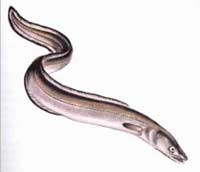People often say “big fish eat small fish”, but the small eels actually eat the big fish. They can slip through the gills of fish to enter the abdominal cavity, consuming the organs and flesh of the fish.
 |
(Photo: relist.net) |
The blind eel can live parasitically in large fish due to its unique structure. The blind eel resembles freshwater eels but lacks an upper jaw; its mouth is simply a suction cup with sharp, horn-like teeth. Its gills are pouch-shaped, with the gill openings directly connected to the throat, and the outer gill openings are far from the mouth at the back, allowing the front part of its body to burrow deep into the fish’s abdomen without affecting respiration. The blind eel uses its suction mouth to attach to the fish’s body, then looks for an opportunity to slip into the fish’s gills. Since the blind eel can live for a long time inside the fish’s stomach, its eyes have degenerated and are hidden beneath the skin. Its sense of smell and four pairs of tentacles are very sensitive, detecting prey nearby immediately.
The blind eel belongs to the group of jawless fish (Cyclostomata), is hermaphroditic, and during mating, it acts as a male first, then later as a female. After fertilization, it does not undergo metamorphosis but directly gives birth to baby eels.




















































